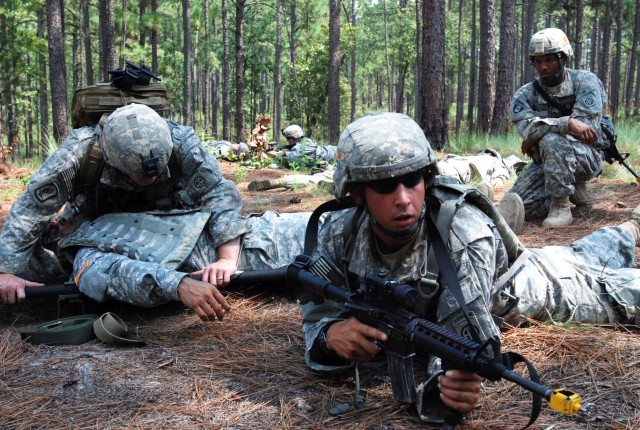
FORT BRAGG, N.C. - Injured Soldiers screamed for help. One gasped for air, struggling with a sucking chest wound as another demanded to know if his buddy was still alive.
Dust clouds hovered over the road as a five-vehicle convoy sped to the scene. As the vehicles slid to a halt, medics leaped from the trucks and took cover behind trees, seeking shelter from incoming fire. They positioned themselves over their wounded comrades to protect them from enemy rounds as they returned fire with M4 carbines.
Honing their skills in casualty evacuation, route reconnaissance, communication, triage and treatment of patients, medical personnel with Company C, 407th Brigade Support Battalion, 2nd Brigade Combat Team conducted casualty evacuation training over the course of three days.
The final mission for the company was a mass casualty evacuation, a situation in which the number of casualties is larger than the medical team. Seven medics responded to a medical evacuation request from Co. A Soldiers who were attacked while operating a tactical water purification system. The team arrived at the scene, deep in the woods of Jessica landing zone, to find 10 wounded Soldiers lying on the ground surrounded by land mines.
They immediately got to work, carefully placing each step to avoid setting off any unexploded ordinance. They began treating wounds, triaging patients depending on the severity of their injuries, and making conversation with the wounded to keep them calm to prevent shock while they did their job.
Injuries were severe, ranging from a sucking chest wound to a Soldier with arm and leg wounds that would require amputation. In a burst of smoke, one medic was "killed" as he turned over a patient who was laying face down in the dirt. The patient had been strapped with a suicide-bomb vest that detonated when his body was moved.
Several times, they took fire from the wood line as opposing forces crept through the brush to prevent them from treating the wounded or getting out of the area safely. However, the barrage did not deter the medics. They tied off tourniquets to Soldiers who were bleeding out and inserted a chest tube into a Soldier who was having trouble breathing, before lying on top of their patients and returning fire. Those whose patients were stable ran from cover to cover to get a better shot at the enemy.
In the few instances when firing ceased, they quickly returned to their mission.
With the patients stabilized and able to be transported, they were strapped to litters as the medics maneuvered them into the backs of the trucks. The convoy traveled to an ambulance exchange point where they met with more medical personnel in emergency vehicles.
Patients were handed off and placed in the ambulances where their injuries were reevaluated. This trade simulated the exchange of patients from line unit medics to a Level II care facility where they could receive additional treatment. "We provide life support for trauma patients we receive from the field," said Spc. Christopher Quick, a Co. C medic, working at the Advanced Trauma Life Support facility. "A line medic's job is to keep them alive long enough to get there."
Once the ambulances were loaded to capacity with wounded Soldiers, they were trucked to the ATLS. There, wounds were cleaned, IVs inserted, and bandages changed. Two patients were taken to the operating room tent for surgery due to their extensive injuries.
This stage in the treatment process, level two of the five levels of care, is a halfway point of treating wounded Soldiers in the field and getting them to a hospital. "We stabilize, treat, and prepare for the transportation of trauma patients," Quick said.
Although while on a deployment to a combat zone, patients would be more likely to be evacuated by helicopter instead of a truck, the treating and triage of patients isn't going to change, said Capt. Francis Cicchini, the company commander.
The entire exercise went quickly, evacuating, triaging, and treating 10 patients in about 40 minutes, all while taking fire and laying suppressive fire, Cicchini said.
"It was a chance to introduce some of our new Soldiers to the mission in a field setting," said 1st Sgt. Chris, unit first sergeant.Jones said.

Social Sharing